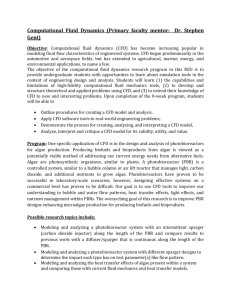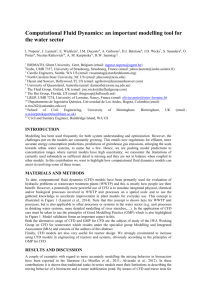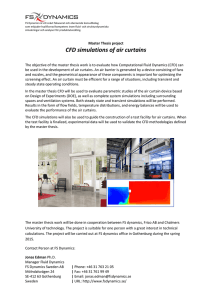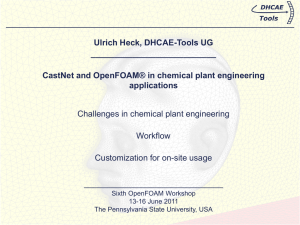APPLYING CFD TO ENVIRONMENTAL FLOWS
advertisement
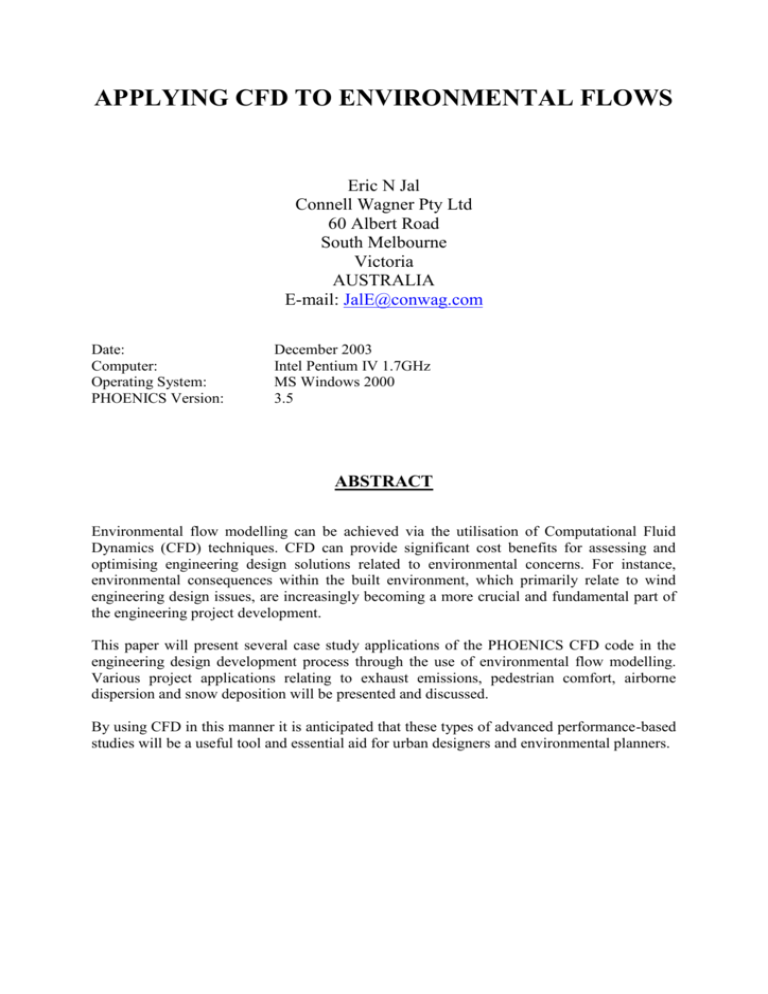
APPLYING CFD TO ENVIRONMENTAL FLOWS Eric N Jal Connell Wagner Pty Ltd 60 Albert Road South Melbourne Victoria AUSTRALIA E-mail: JalE@conwag.com Date: Computer: Operating System: PHOENICS Version: December 2003 Intel Pentium IV 1.7GHz MS Windows 2000 3.5 ABSTRACT Environmental flow modelling can be achieved via the utilisation of Computational Fluid Dynamics (CFD) techniques. CFD can provide significant cost benefits for assessing and optimising engineering design solutions related to environmental concerns. For instance, environmental consequences within the built environment, which primarily relate to wind engineering design issues, are increasingly becoming a more crucial and fundamental part of the engineering project development. This paper will present several case study applications of the PHOENICS CFD code in the engineering design development process through the use of environmental flow modelling. Various project applications relating to exhaust emissions, pedestrian comfort, airborne dispersion and snow deposition will be presented and discussed. By using CFD in this manner it is anticipated that these types of advanced performance-based studies will be a useful tool and essential aid for urban designers and environmental planners. INTRODUCTION Quite often for a major construction project an environmental audit will be included as part of the scope. This is necessary to address both the short-term and long-term impacts and to ensure that the consequences caused by the engineering scheme have minimal impact on both the environment and occupants using the space. As such environmental consequences within the built environment, which primarily relate to wind engineering design issues, are now a crucial and fundamental part of the engineering project development process. With the growing public awareness of the need for environmental protection, it is apparent that state-of-the-art technology will become increasingly important in all aspects of environmental management. As a consequence, computer simulation is becoming routinely used for conducting environmental impact assessments. Computational Fluid Dynamics (CFD) is one such tool that can provide significant cost benefits for assessing and optimising engineering design solutions related to environmental concerns. The following section provides a list of case studies using the PHOENICS CFD code in the engineering design development process for assessing the environmental flow impacts relating to exhaust emissions, pedestrian comfort, airborne dispersion and snow deposition. CASE STUDIES City Square – Melbourne, Victoria When designing the new City Square precinct in the Melbourne CBD, the developers incorporated a new underground car park. However, due to architectural constraints the only possible location of the exhaust stack was through the centre of a street level café. Concerns were thus raised of the discharge upon café patrons and upon adjacent buildings, one of which was a hotel with exposed balconies facing onto the square. CFD modelling was conducted to assess the effect of stack discharge for different wind conditions. From the results of the analysis, an optimum height and size of duct and exhaust discharge velocity was recommended which would mitigate the effects of the exhaust dispersion upon the café patrons and hotel occupants. Holdfast Shores – Adelaide, South Australia The Holdfast Shores project is major multi-use precinct development situated at Glenelg, on Adelaide’s coastal strip. Concerns relating to pedestrian comfort and safety on a footbridge, due to its position downstream of a potential “wind-gully”, were addressed in the engineering design by conducting a CFD modelling study. A key aesthetic feature of any proposed ‘wind-break’ structure to mitigate the problem of wind gusts was that it should have minimal impact upon the surrounding area. Various remedies were assessed in the CFD analysis including the incorporation of vegetation (pine trees), art block sculptures and semi-transparent (wire-mesh) screens. Urban City Planning – Wellington, New Zealand The City of Wellington in New Zealand regularly experiences high wind speeds which make pedestrian comfort and safety aspects a prominent and relevant issue for urban planning development. In order to mitigate the adverse effects of the wind, specific rules apply as conditions for permitted building development. As a consequence, designers and developers must demonstrate to the Wellington City Council that their proposed building development will have no adverse effects on the local wind conditions experienced around its vicinity. As an aid to this process, CFD can be a useful tool for city planners and designers in such circumstances and can establish the influence of any proposed building development upon the local wind environment. The results from the CFD modelling provide a detailed analysis of the local wind speeds and levels of turbulence and highlight the impact upon pedestrian comfort and safety. In this way the building form can be changed early in the design stage process and enable urban planners to develop safe, yet commercially viable solutions. Perisher Valley Resort – New South Wales The NSW National Parks and Wildlife Service (NPWS) have recently redeveloped parts of the holiday village accommodation areas of the Perisher Valley resort complex. Issues were raised during the Environmental Impact Statement (EIS) for the village redevelopment concerning the likely pattern of snow drifting around the building landscape during winter. Two alternative designs had been proposed and the NPWS needed to establish out of the two configurations which would have the higher snow deposition around the new and existing buildings as well as the pedestrian concourse areas. By using CFD, sensitivity analyses were performed to investigate the impact of the snow deposition for the two different development configurations. The study performed demonstrated that the CFD model developed could be utilised as a practical tool for architectural planning purposes and provide meaningful results, but without the recourse to an extensive research study. City Link Burnley Stack – Melbourne, Victoria One part of the City Link project involved the construction of two three-lane underground tunnels, one 3.4km long and the other 1.6km long, located adjacent to the Melbourne CBD. This facilitated the linking of several major arterial freeways which allows through traffic to bypass the city centre. The tunnels incorporate vent stacks that cater for the dispersion of the vehicular exhaust emissions from within the tunnels. As part of the Environmental Protection Authority (EPA) policy, the emissions from the vent stacks need to be measured and monitored to ensure that pollutant concentrations are below statutory levels, due to the close proximity of the vent stacks to commercial and residential dwellings. During the commissioning stages of the tunnel construction, it was discovered that the discharge flow within the exhaust stack where the sampling probes were positioned (midway up the vertical shafts) was non-uniform and unsteady (fluctuating). As a result the sampling probes were unable to be satisfactorily calibrated. In order to avoid any delay in the opening of the tunnel, along with associated stringent financial penalties to the construction consortium, a solution to this problem had to be found within a very short time scale. To assist in this process a CFD study was undertaken to establish the flow characteristics through the stacks and to determine a satisfactory solution. The CFD analysis indicated that for the existing as-built configuration the presence of significant flow recirculation within the lower chamber in-between the two banks of attenuators. This is caused by the flow expansion into the lower chamber from the first bank of attenuators and extraction fans. This was postulated in introducing extra turbulence and flow instabilities as the flow enters the base of the vertical stack, which subsequently produce the non-uniform and fluctuating air velocities detected at the monitoring probe locations. Based upon the results from the CFD analysis, internal fairings and turning vanes were recommended to be installed at the entrance base of the stack. This was subsequently found in practise to eliminate the problem such that the discharge emissions could be satisfactorily monitored to the required EPA regulatory practice. CONCLUSIONS The use of CFD in assessing and optimising engineering design solutions related to environmental concerns has been demonstrated through several case studies. This has established issues relating to exhaust emissions, pedestrian comfort, airborne dispersion and snow deposition can be adequately addressed using CFD techniques and may also provide significant cost benefits to the overall engineering project development. It is anticipated that by using CFD in this manner these types of advanced performance-based studies will be a useful tool and essential aid for urban developers, architectural designers and environmental planners in establishing and controlling environmental consequences within the built environment.
